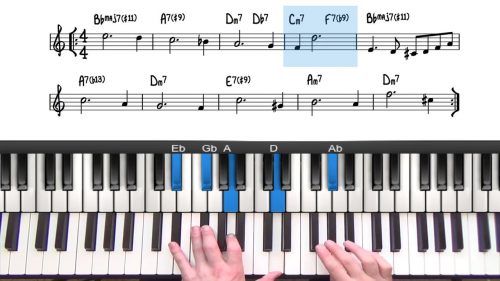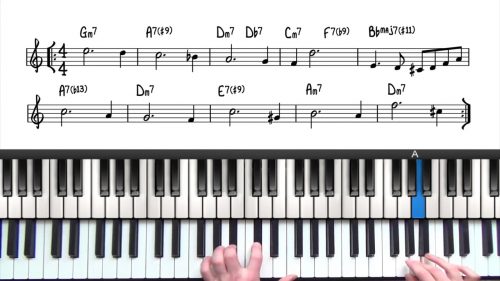Have You Met Miss Jones Tutorial
‘Have You Met Miss Jones’ is written in the key of F Major and is usually played at a fast tempo. The tune was originally written by Richard Rodgers for the musical comedy ‘I’d Rather Be Right’ and has since been recorded by many of the great jazz musicians such as Art Tatum, Hank Jones, Kenny Barron, Chet Baker and Oscar Peterson.
The chord changes weave through many different keys particularly in the B Section which contains back-to- back 251s in Bb Major, Gb Major, D Major and then back to the tonic key F Major for the final A section.
The tonal centers of the 251s in the bridge move by major thirds which is said to have served as inspiration to the jazz saxophonist John Coltrane, in the development of the ‘Coltrane Changes’ which follow the same harmonic pattern. These chanes can be found in many of his tunes — ‘Giant Steps’ and ‘Countdown’ being two of his most famous compositions.
We start the tune with left hand voicings and the melody, and then the second time through we’re going to keep up the fast tempo but add some more interesting voicings, chord substitutions and rehamonisations.
Practice Tips
-
First learn to play through the form with left hand voicings.
-
Then move onto the 2 handed arrangement.
-
This jazz standard has been widely recorded so make sure you are listening to the records for additional inspiration.







Unbelievably great arrangement. It really sounds like a great cocktail jazz arrangement, very professional sounding. I really loved the Bflat dom 7 passing chord in the first measure, but if you hadn’t put in the Am7, maybe you never would have thought of it??? and the whole series of chords from the turnaround through the whole A section is very tasteful.
I have a question. re bars 7 and 8. You moved the Gm7 into bar 8 . Then you preceded this measure with a 2-5 in Gflat major in bar 7. Your chord subs seem to be just 2-5 in keys that descend by half steps, i.e 2-5 in G flat followed by 2-5 in F, and then resolving to the Fmaj. Is this the way you thought of these subs, or were you thinking of something more complicated?
And do you do this a lot, I hadn’t noticed this exact thing before, and it seems useful.
Thanks, I’m getting a ton out of these courses.
BG
Hi Brad,
I’m really glad you enjoyed the arrangement.
Yes the Bb7 passing chord is a nice touch in the first bar. Remember that we can approach any chord with a dominant chord a 5th above, and also the tritone substitute as in the case here.
I created a short 5 minute lesson here on dominant passing chords which you might find useful: pianogroove.com/jazz-piano-lessons/slick-dominant-passing-chords/
And yes the chromatic 25 progression in bars 7 and 8 is exactly the best way to look at it. If we play any 251 progression, and then precede it with a 25 a half step up it always sounds pleasing to the ear. A key consideration is the melody note, in this example I actually deviate away the melody which is the Bb tied across the final 2 bars of the 1st A Section.
We could actually play all of those chords without changing the melody note, Bb is the 9th of Ab-7 and the 13th of Db7, then it becomes the 3rd of G-7, and the b7 of C7, and so we could play all of those voicings with the Bb melody note held.
We also have the tritone sub option which I like, try keeping that Bb melody note held down, and then play the following turnaround: Ab-7 / Db7 / G-7 / Gb7 –> Fmaj7
It’s good to memorise the little details of this reharmonisation so that we can find opportunities to apply it in other situations, for example, the Bb melody note is the 3rd of G-7, and so when we come across a 251 like this when we have the 3rd in the melody over the ii-7 chord, if we have the time and space in the tune, we can always insert this reharmonisation.
Another example of where this would work would be the B Section of “There Will Never Be Another You” – see my graphic attached.
As an exercise try to apply the same reharm to those 2 bars, and then flick through the standards you play and try to find more opportunities to add this half step 25 pattern.
I hope that helps Brad and any other questions just let me know.
Cheers,
Hayden
Thank you very much for the helpful thoughtful answer. In trying to get up to speed on these chord changes, I found that it was easier to go ahead and memorize the tune so i wouldn’t have to look at the lead sheet. That was a super nice surprise, believe me. I never could memorize lead sheets, now I want to.
It’s easier to memorize the lead sheet chord changes because of all the 251s so now I know what chord should follow.
I thought for sure that somewhere in your courses I saw a lesson just on memorizing lead sheets, but I can’t find it, although I did find a lesson on the forms the lead sheets take.
Is there a lesson just on memorizing lead sheets? I’m about to watch the lead sheets forms lesson, maybe that was it.
Thanks again for your help.
BG
My pleasure Brad.
Yes in addition to the jazz forms lesson, we also have 2 seminars dedicated to this topic.
Here is the first one taught by myself: pianogroove.com/live-seminars/arranging-jazz-standards
and here is the second one taught by Tuomo: pianogroove.com/live-seminars/memorising-jazz-standards/
It’s nice to get different perspectives on the same topic so I would recommend watching both.
And yes, the more tunes that we learn, the more similar we realise they are, and the memorisation process becomes simpler and quicker with each tune that we learn. I’m sure the above 2 seminars will give you some more useful insights too.
Cheers!
Hayden
Hi Hayden, I am enjoying thie lesson and it is challenging… would it be possible to have a transcription? it will serve as a guide for me.
Thanks so much.
Hi Dan,
Sorry for the late reply, I missed this comment.
Yes I will send this lesson to our transcriber to notate the chords and voicings that I am using.
I agree it will be useful for students studying the lesson.
I will reply to this comment to notify you when it is ready.
Talk soon, cheers,
Hayden
Hi Hayden is a transcription for this still in the works?